Sunday, 2 October, Melk, Austria (to visit the abbey)
Written 14 February 2023
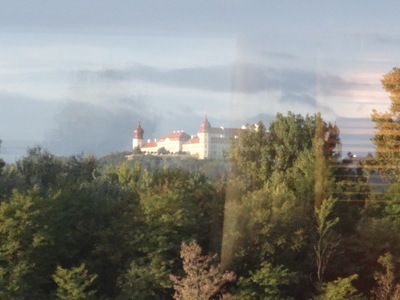
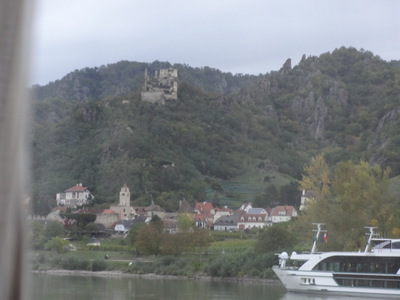 The ship sailed about midnight, headed for our next stop, Melk, which David and I had visited briefly when the meiofauna congress was held in Vienna many years ago (back before I kept on-line travel diaries, and I'm not going to take time away from writing this to look up the date).
The ship sailed about midnight, headed for our next stop, Melk, which David and I had visited briefly when the meiofauna congress was held in Vienna many years ago (back before I kept on-line travel diaries, and I'm not going to take time away from writing this to look up the date).
I'm afraid I've lost track of the identity of the imposing building left-hand photo; it stood high above the river as we commenced our "scenic cruising of the Wachau Valley" in midmorning.
But I'm pretty sure that the ruin in the right-hand photo is of Dürnstein, the (or maybe just a) castle where Richard the Lionhearted was held for ransom in the 12th century. Richard's faithful minstrel supposedly traveled the length of the river and paused below the walls of every castle to sing a song only he and Richard knew and succeeded at last in finding out where he was held.
The village of Spitz is marked by the ruins of Castle Hinterhaus (no photo), has 1700 inhabitants, and has been here at least since 830 AD. It makes mostly riesling wines but a small amount of merlot. Viennese people have weekend houses in Spitz, which boasts a nice riverside bike path.
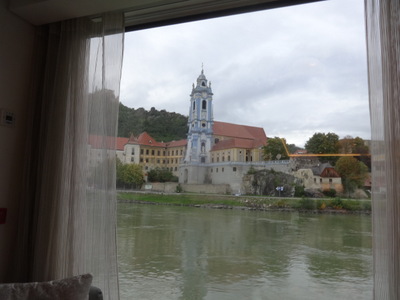
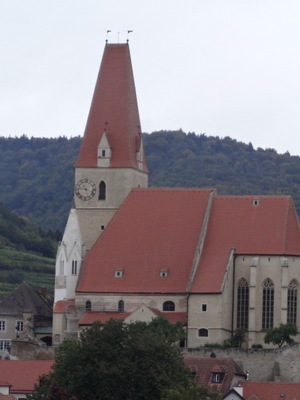 Strangely I have contradictory notes about the beautiful blue abbey tower in the left-hand photo. First I note that it was built with the ransom money they got for Richard, but the next note says that, no, it was built with money from successful dealing in wine and grain. Not sure which is right.
Strangely I have contradictory notes about the beautiful blue abbey tower in the left-hand photo. First I note that it was built with the ransom money they got for Richard, but the next note says that, no, it was built with money from successful dealing in wine and grain. Not sure which is right.
The photo at the right is of the fortified church in Weissenkirchen (at mile 2013 of the Danube). I have disjointed notes about it—a stronghold of the protestants, ransacked by rebellious peasants in 1596, important in the ending of the 30-years' war. It dates from 897 and was once the most important church in the Wachau.
In the steep vineyards on the river banks were what looked like pipelines coming down the hills, but I know they're not for irrigation. Seems as though last year we learned they have to do with transporting grapes down the hill during the harvest.
Written 15 February 2023
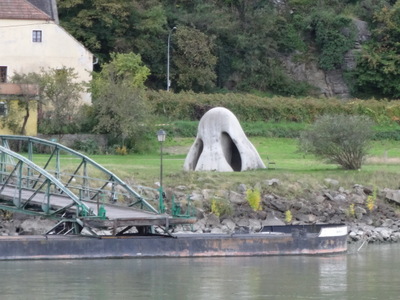
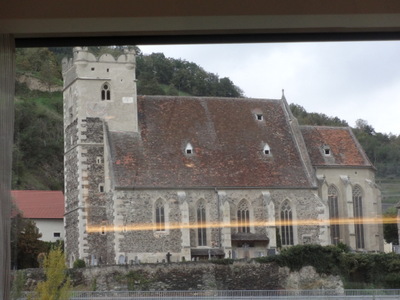 Soon after we passed the fortified church, Marek pointed out the work of art in the left-hand photo: the Nose of the Wachau. It's larger than it looks in this view—you can stand up inside the nostrils—and it's made of concrete. The little bridge next to it is the landing of the Danube cable ferry at Sankt Lorenz. The ferry itself, large enough to carry vehicles, is not motorized. Like the one we saw in Basel, it is pushed toward one bank or the other by the river's current, depending on which way the rudder is set.
Soon after we passed the fortified church, Marek pointed out the work of art in the left-hand photo: the Nose of the Wachau. It's larger than it looks in this view—you can stand up inside the nostrils—and it's made of concrete. The little bridge next to it is the landing of the Danube cable ferry at Sankt Lorenz. The ferry itself, large enough to carry vehicles, is not motorized. Like the one we saw in Basel, it is pushed toward one bank or the other by the river's current, depending on which way the rudder is set.
At the right the Church of St. Michael, known as the "rabbit church" because of of the line of metal rabbits running along the peak of its roof. No one is quite sure why rabbits, but legend has it that the snow was so deep one year that hares were able to jump onto the roof. Its tower is not ruined; it was deliberately built that way, flat on top. Sorry about the orange streak across the image—it's the reflection of the lounge's ceiling strip lighting, which was really hard to keep out of the photos.
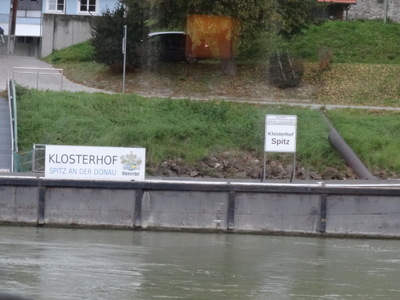
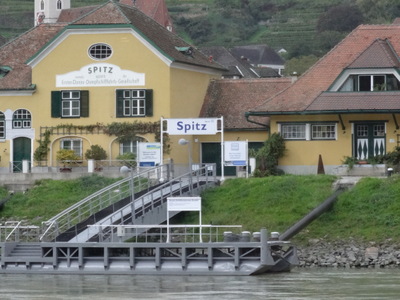 Each little town and village we passed had a boat landing, with signage reminding you where you were. Some of the businesses depend on tourism—the Wachau is justly famous for its scenic beauty. (Fellow passengers were up on the sundeck taking pictures of the scenery, and because it was pretty nippy up there this morning, the kitchen sent up trays of hot chocolate to them.) It's also the site of many vacation homes owned by people from Vienna. But in addition to vineyards, the valley is known for the production of prune plums, apricots, and other stone fruit, so I'm sure that permanent residents tended orchards.
Each little town and village we passed had a boat landing, with signage reminding you where you were. Some of the businesses depend on tourism—the Wachau is justly famous for its scenic beauty. (Fellow passengers were up on the sundeck taking pictures of the scenery, and because it was pretty nippy up there this morning, the kitchen sent up trays of hot chocolate to them.) It's also the site of many vacation homes owned by people from Vienna. But in addition to vineyards, the valley is known for the production of prune plums, apricots, and other stone fruit, so I'm sure that permanent residents tended orchards.
My photos of the morning's cruise are hard to line up with my notes, but here are some of the highlights pointed out to us:
- The devil's wall is a diagonal cliff with very large scree at the bottom. Apparently either the devil or his mother in law (depending on who you ask) ripped the rocks from the cliff wall and flung them into the Danube to keep Crusader ships from passing.
- Schwallenbach has a gothic church from 1860 and 88 inhabitants. It also has a fruit orchard quite near the edge of the river, so we got a look at the trees.
- Willendorf is famous for discovery of the Venus of Willendorf, a little stone figurine of a woman thought to be one of the earliest known works of art.
- Aggstein is known for the ruins of its castle, which dominates the Danube at this narrow point; it was destroyed and rebuilt several times before the final destruction in the19th century. On the other side of the river, Augsbach market is a popular resort.
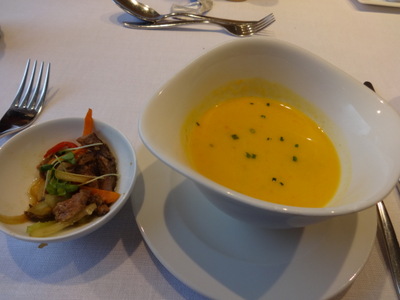
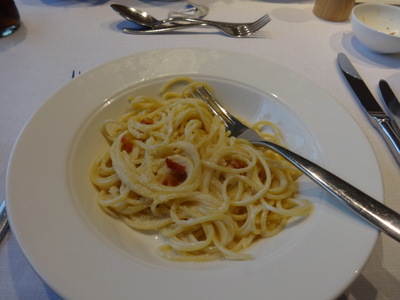 Lunch was served early, to accommodate the afternoon's touring schedule. The starter was carrot and orange soup, with orange segments. That's is at the left, together with one of the fine-print starters, which incorporated roasted vegetables and strips of leftover beef.
Lunch was served early, to accommodate the afternoon's touring schedule. The starter was carrot and orange soup, with orange segments. That's is at the left, together with one of the fine-print starters, which incorporated roasted vegetables and strips of leftover beef.
At the right is my main course—pasta carbonara. As usual, very good, but very skimpy on the sauce.
Over lunch, we compared notes with Jan and the McQuaids, who did Vienna excursions different from ours. Jan tells us that in Budapest, an old river cruise boat has been turned into a highschool for 200 students with a 300-student waitig list. A Russian cruise company went out of business, and the city wound up with one of their boats.
And Sallie McQuaid says that taking this double cruise will count as two cruises for us in Viking's eyes. Hope some perks come with that . . .

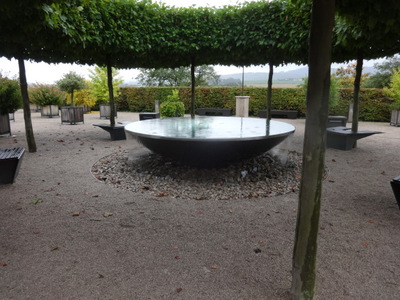 During lunch, we arrived at Melk. We had to moore outboard of another ship, from the Nicko
cruise line, and pass through it to reach the dock, so I had to turn around and shoot back toward the river to get this photo of the sign.
During lunch, we arrived at Melk. We had to moore outboard of another ship, from the Nicko
cruise line, and pass through it to reach the dock, so I had to turn around and shoot back toward the river to get this photo of the sign.
Our bus left at 12:45 pm, and a second one followed at 1:50 pm. Shortly after that, the ship cast off and headed upstream, where it would rendezvous with is at Ypps. As we had been told in the previous evening's briefing, from the parking lot where the buses dropped us, we would walk 10 minutes downhill to the abbey, starting with 64 stair steps down. Because I try to coddle my knees (and I'm a lazy bum), we took the elevator). It was drizzling, but on days like that, Viking staff magically produce bales of large, bright-red, Viking-logo umbrellas, which they issue as you leave the ship. We were wearing hooded rain jackets, so we didn't need one.
The stroll to the abbey itself, mostly level at that point, led through lovely container gardens. At the right is a very serene fountain—water welled up in the center and overflowed to pour over the rim in a smooth curtain all the way around. It was surrounded by straight young trees ("sycamore" maples, I think) that had been pleached into the shape of a circular elevated hedge.
At the left-hand edge of the photo, you can see some of the large containers, planted with a mixture of citrus trees, huge lantanas, olive trees, laurels, oleanders, palms, and bamboo. A large (but rather overgrown) her garden was planted in the ground. I assume they take the planters inside in the winter—the abbey is perched high on a hillside above the town and the river, and the winter winds up there must be fierce.

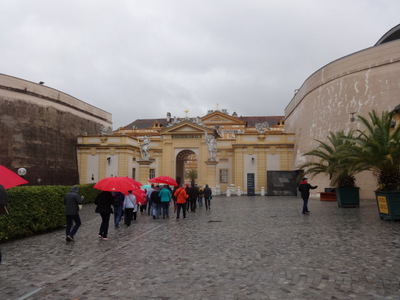 At the left here is a map of the abbey and its grounds. The abbey itself is the red-roofed complex at the left (the taller, blue-domed building is the church). We arrived in the parking lot at the lower right and followed the lower edge of the map to the abbey. The darker-red-roofed building between the two, near the bottom, is a restaurant, and we passed through the container garden in front of it. I would have liked to spend some time in the large gardens behind the restaurant, but time did not permit.
At the left here is a map of the abbey and its grounds. The abbey itself is the red-roofed complex at the left (the taller, blue-domed building is the church). We arrived in the parking lot at the lower right and followed the lower edge of the map to the abbey. The darker-red-roofed building between the two, near the bottom, is a restaurant, and we passed through the container garden in front of it. I would have liked to spend some time in the large gardens behind the restaurant, but time did not permit.
The legend of the map is too small to read here, but blown up, it reveals that the outbuildings include a biomass power plant as well as a solar array. The red oval is the track and athletic fields, presumably for use by students of the abbey school.
The photo at the right shows our approach to the gate into the abbey's main courtyard. Note all the red umbrellas!
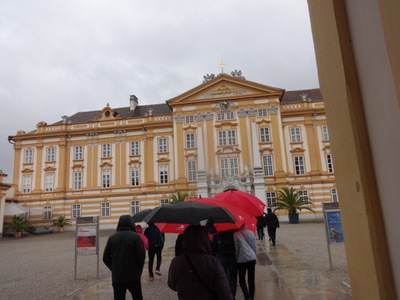
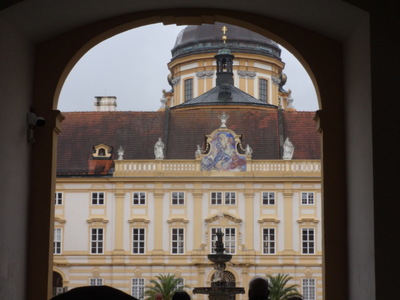 At the left here, we are in the main courtyard, and the view at the right is through the arch at its far end into a smaller courtyard. I think that view is actually of the chevet end of the church.
At the left here, we are in the main courtyard, and the view at the right is through the arch at its far end into a smaller courtyard. I think that view is actually of the chevet end of the church.
The guided tour took about an hour, but unfortunately, no photos were allowed during most of it, so you'll just have to wade through my narration of it.
First, parts of the movie The Name of the Rose was filmed at Melk, so Sean Connery and Christian Slater (and Ron Perlman!) presumably trod these same halls and probably got into parts of the library where we were allowed to go.
- The place was originally built as a residence of the Babenberg rulers of Austria (or whatever empire covered this area at the time). The semicircular bastions (Babenberg towers) you can see in the approach to the entrance are more than 1000 years old; they show that the buildings were originally a fortress. The one facing the river was actually defensive; the second was built just to be symmetrical with the first. In 1089, Leopold II of that family gave it to a group of Benedictine monks, who founded the abbey. They in turn founded a school in the 12th century.
- The abbey has 1365 windows and 97 rooms. All still in use, most by the school which is still in operation.
- It's currently occupied by 24 monks, ages 47 to 90, but 300 people work there, including gardeners, electricians, etc. The monks still live next to the church. During the reformation and counterreformation, there were only 8 monks; in baroque times, there were 100.
- The monks serve as priests in local parishes. One teaches outside the abbey, one is the abbey's librarian, and two teach in the abbey school.
- The school has 845 students, ages 11 to 18 (all day students), and 85 teachers. They pay 104 euros/month and wear uniforms. Students in the school can believe anything so long as they believe, so they include, e.g., Lutherans and Jews. They must live within a half-hour radius of travel.
Queens and emperors have stayed here as guests, including Empress Maria Theresa and her husband Francis Steven, who stayed twice or three times, with a retinue of 250.
The exhibition we visited were the former imperial rooms. We entered in the middle of a very long corridor with a beautiful chestnut, maple, and cherry floor. Every room was furnished with an original tile stove and had its original floors and plaster ceiling. The stoves are no longer in use, because central heating has been installed.
The first room we entered was blue, symbolizing the beginning of the Benedictine order, founded in 529 in Italy. The Abbey has an 800-year-old copy of the Benedictine rule. A word meaning "listen" is projected on the wall. Elements of the Benedictine rule are "Pray, work, and read," obediance, and the monastic way of life. Benedictines must never stand still; they should be moving and doing.
The second room was green, symbolizing growing. The abbey also has Swanhilde's portable altar, which is ore than a thousand years old, it's the oldest treasure. It's wooden, about the size of a large cigar box, and decorated with bone, bronze, and paste jewels.
The most important treasure is the Melk cross, decorated with emeralds and other precious stones. Inside it is a splinter of the cross, which Leopold gave to the monks along with the abbey.
In 1597 a horrible fire destroyed the place, but the monks were able to save most of the manuscripts that form the basis of its justly famous library.
In the 15th century, the Benedictines were reformed and the abbey became a center for monastic life and produced many manuscript books in its scriptorium.
A tiny room symbolizes the middle ages and displays an 800-year-old wooden crucifix.
Bertholde von Dietmeyer, 1700-1730, was the abbott who demolished the old abbey and built this nice large harmonious one. The current baroque buildings were designed by architect Jakob Prandtauer.
A mirror-lined room represents heaven. It displays many gilded items, monstrances, and statues. Actually, all the gilded things are made of wood and covered with gold leaf. The whole abbey contains just 4 kg of actual gold.
The elaborate vestments in the museum are still used on special occasions. The current abbot is quite young at 73, and he till wears the 18-kg robe and carries the heavy staff.
A side note about Joseph II, son and successor of Maria Theresa: He didn't like baroque. He was a man of reason and always kept a window open to bring in the light of reason. He didn't believe every person needed his or her own coffin, so he had designed trap-door coffins (The coffin was lowered partway into the grave before the corpse was dropped through the bottom into the grave and the coffin was retrieved for reuse—the design was soon discontinued, because people didn't like it). He designed cheap leather vestments. He founded schools and hospitals and introduced religious freedom. Sounds like an interesting guy.
In 1502 Jörg Breu the Elder from Augsburg came to Melk to paint alterpieces we were shown. We were also shown a very long gallery with art representing 1000 years of Austrian rulers; their portraits line the walls, starting with the Babenbergs, who were then followed by the Hapsburgs.
We were also shown a large wooden chest with a huge and complicated lock mechanism that fills the whole lid.
The marble hall was originally the dining hall for the imperial family. Its ceiling fresco was painted by Paul Troger in 1731, within an architectureal framework painted by Gaetano Fanti. The ceiling is actually flat, but you'd swear it was domed. The trompe l'oeuil effectvis perfect from the grate in the middle of the floor but it's pretty wacko from the edges of the room. The door frames are solid marble, but the rest is stucco painted to resemble marble. It's 300 years old, and I think the guide said that it would be cheaper now to build it of real marble than to have it painted to resemble marble.
In the 1920s, funds were needed to restore the abbey's roof, so they sold a Gutenberg bible to Yale University and used the money to redo the whole roof.
Yup, pretty disorganized account, but that's the order we were shown and told things. Actually, I even reorganized some of it to be less chaotic—for example, the paragraph about the school and the one about the present number of monks were each assembled from notes I took at different points in the tour.
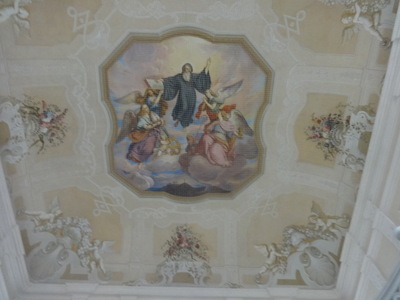
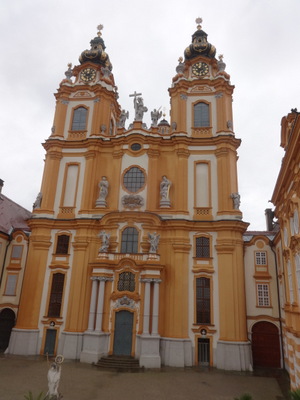 Here's the one interior photo we were allowed—the ceiling above a grand marble staircase. I think the guide said it's by the same artist who did the marble hall; it's been cleaned but is otherwise original and 300 years old.
Here's the one interior photo we were allowed—the ceiling above a grand marble staircase. I think the guide said it's by the same artist who did the marble hall; it's been cleaned but is otherwise original and 300 years old.
From there we went outside to the "balcony," a courtyard that looks out over the town and the river, 60 m below. The photo at the right was taken with my back to the view. It's the baroque facade of the abbey church, devoted to Saints Peter and Paul.
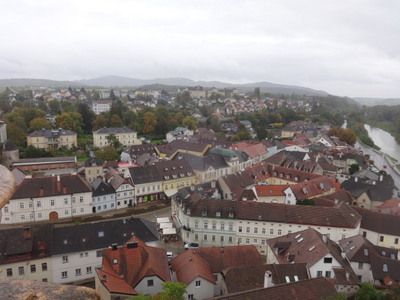
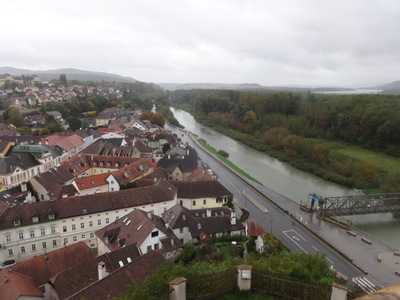 Here's the view from the balcony. The little watercourse below is not the Danube but a smaller tributary or canal. You can see a little of the main river at the top right, over the trees.
Here's the view from the balcony. The little watercourse below is not the Danube but a smaller tributary or canal. You can see a little of the main river at the top right, over the trees.
As was the case on many of our excursions, tour guides were not allowed inside the church, but we were allowed to go in and look around on our own, still without photogaphy. A Latin inscription above the altar says "without a legitimate battle, there is no victory."
The real gem, though, was the library. We were only allowed into the first of its 10 rooms, which we were told is also the most beautiful. Eight of the rooms are on this level, and another two are upstairs, reached by a spiral staircase. The guide assured us that the library held no illusions—the 12-m-high ceiling really is domed. This one room held 9000 books, all printed. The hand-written books are stored in other rooms, to which only the librarians have access. One manuscript is 1200 years old. They also have an Easter calendar written by the venerable Bede, who was also a composer and knew a lot about herbs.
No flames or gas light was ever allowed in the library, because of the danger of fire. Instead, six hidden doors can be opened to reveal windows that let light in for reading.
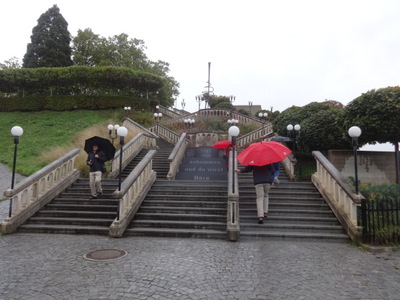
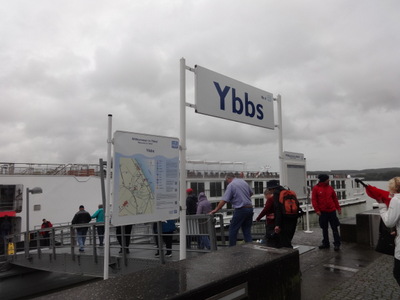 Here, at the left are the actual 64 steps up to the parking lot. We took the elevator again. Promptly at 3:30 pm, all groups piled back into their buses for the 1-hour trip upriver to catch the ship.
Here, at the left are the actual 64 steps up to the parking lot. We took the elevator again. Promptly at 3:30 pm, all groups piled back into their buses for the 1-hour trip upriver to catch the ship.
We found it waiting for us, as planned, at Ypps. As soon as we were all back aboard, it case off again and started toward tomorrow's destination, Passau.
At 5:45 pm, we were invited to the Viking Explorers' Society cocktail party. Anyone who has taken more than one cruise with Viking is automatically a member. The only difference between this party and just gathering in the lounge for predinner cocktails, as we do every evening is that, during the VES half hour, drinks are free, and they pass cocktail munchies on trays.
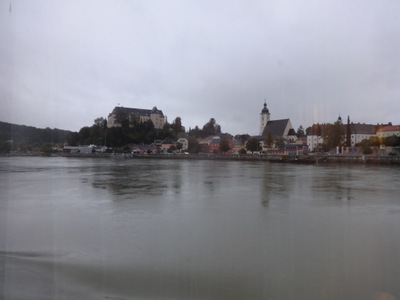
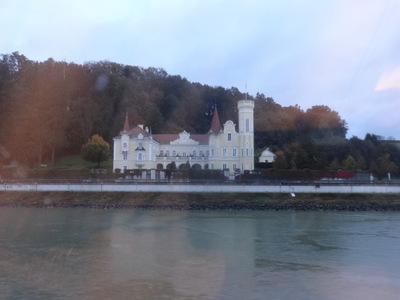 During the party and dinner, we passed these two handsome buildings, but because no one was narrating, and no program was in progress, I have no idea what they were.
During the party and dinner, we passed these two handsome buildings, but because no one was narrating, and no program was in progress, I have no idea what they were.
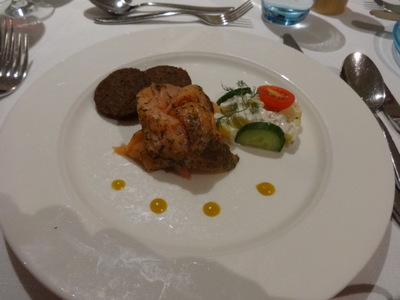
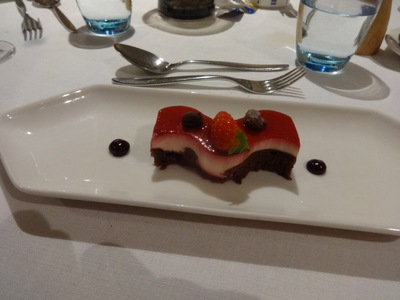 For dinner, I started with excellent Norwegian gravlax, accompanied as is traditional by dots of a sweet mustard sauce, a little potato salad, and circles of dark bread. I swear, Viking must contract for tons of Norwegian salmon per week!
For dinner, I started with excellent Norwegian gravlax, accompanied as is traditional by dots of a sweet mustard sauce, a little potato salad, and circles of dark bread. I swear, Viking must contract for tons of Norwegian salmon per week!
I don't have a photo of my main course, but knowing my own tastes and David's, we probably both ordered the roasted duck breast with shiitakes, butternut squash, and Korean BBQ sauce (rather than the vegan bean chili).
For dessert, I went to the regional-specialties menu for "Donauwelle," Germany cherry chocolate cake cut into the shape of a "Danube wave."
In the evening, Marek was scheduled to give a lecture on Mozart, but he warned us ahead of time that, because his first few audiences seemed bored, he has unleashed his flamboyant side and now dresses up like Mozart and delivers the whole lecture is skit form. So I stayed in my cabin and worked on this diary. I would have watched on the lounge cam, but it was still out of commission.
Previous entry
List of Entries
Next entry

 The ship sailed about midnight, headed for our next stop, Melk, which David and I had visited briefly when the meiofauna congress was held in Vienna many years ago (back before I kept on-line travel diaries, and I'm not going to take time away from writing this to look up the date).
The ship sailed about midnight, headed for our next stop, Melk, which David and I had visited briefly when the meiofauna congress was held in Vienna many years ago (back before I kept on-line travel diaries, and I'm not going to take time away from writing this to look up the date).
 Strangely I have contradictory notes about the beautiful blue abbey tower in the left-hand photo. First I note that it was built with the ransom money they got for Richard, but the next note says that, no, it was built with money from successful dealing in wine and grain. Not sure which is right.
Strangely I have contradictory notes about the beautiful blue abbey tower in the left-hand photo. First I note that it was built with the ransom money they got for Richard, but the next note says that, no, it was built with money from successful dealing in wine and grain. Not sure which is right.
 Soon after we passed the fortified church, Marek pointed out the work of art in the left-hand photo: the Nose of the Wachau. It's larger than it looks in this view—you can stand up inside the nostrils—and it's made of concrete. The little bridge next to it is the landing of the Danube cable ferry at Sankt Lorenz. The ferry itself, large enough to carry vehicles, is not motorized. Like the one we saw in Basel, it is pushed toward one bank or the other by the river's current, depending on which way the rudder is set.
Soon after we passed the fortified church, Marek pointed out the work of art in the left-hand photo: the Nose of the Wachau. It's larger than it looks in this view—you can stand up inside the nostrils—and it's made of concrete. The little bridge next to it is the landing of the Danube cable ferry at Sankt Lorenz. The ferry itself, large enough to carry vehicles, is not motorized. Like the one we saw in Basel, it is pushed toward one bank or the other by the river's current, depending on which way the rudder is set.
 Each little town and village we passed had a boat landing, with signage reminding you where you were. Some of the businesses depend on tourism—the Wachau is justly famous for its scenic beauty. (Fellow passengers were up on the sundeck taking pictures of the scenery, and because it was pretty nippy up there this morning, the kitchen sent up trays of hot chocolate to them.) It's also the site of many vacation homes owned by people from Vienna. But in addition to vineyards, the valley is known for the production of prune plums, apricots, and other stone fruit, so I'm sure that permanent residents tended orchards.
Each little town and village we passed had a boat landing, with signage reminding you where you were. Some of the businesses depend on tourism—the Wachau is justly famous for its scenic beauty. (Fellow passengers were up on the sundeck taking pictures of the scenery, and because it was pretty nippy up there this morning, the kitchen sent up trays of hot chocolate to them.) It's also the site of many vacation homes owned by people from Vienna. But in addition to vineyards, the valley is known for the production of prune plums, apricots, and other stone fruit, so I'm sure that permanent residents tended orchards.
 Lunch was served early, to accommodate the afternoon's touring schedule. The starter was carrot and orange soup, with orange segments. That's is at the left, together with one of the fine-print starters, which incorporated roasted vegetables and strips of leftover beef.
Lunch was served early, to accommodate the afternoon's touring schedule. The starter was carrot and orange soup, with orange segments. That's is at the left, together with one of the fine-print starters, which incorporated roasted vegetables and strips of leftover beef.
 During lunch, we arrived at Melk. We had to moore outboard of another ship, from the Nicko
cruise line, and pass through it to reach the dock, so I had to turn around and shoot back toward the river to get this photo of the sign.
During lunch, we arrived at Melk. We had to moore outboard of another ship, from the Nicko
cruise line, and pass through it to reach the dock, so I had to turn around and shoot back toward the river to get this photo of the sign.
 At the left here is a map of the abbey and its grounds. The abbey itself is the red-roofed complex at the left (the taller, blue-domed building is the church). We arrived in the parking lot at the lower right and followed the lower edge of the map to the abbey. The darker-red-roofed building between the two, near the bottom, is a restaurant, and we passed through the container garden in front of it. I would have liked to spend some time in the large gardens behind the restaurant, but time did not permit.
At the left here is a map of the abbey and its grounds. The abbey itself is the red-roofed complex at the left (the taller, blue-domed building is the church). We arrived in the parking lot at the lower right and followed the lower edge of the map to the abbey. The darker-red-roofed building between the two, near the bottom, is a restaurant, and we passed through the container garden in front of it. I would have liked to spend some time in the large gardens behind the restaurant, but time did not permit.
 At the left here, we are in the main courtyard, and the view at the right is through the arch at its far end into a smaller courtyard. I think that view is actually of the chevet end of the church.
At the left here, we are in the main courtyard, and the view at the right is through the arch at its far end into a smaller courtyard. I think that view is actually of the chevet end of the church.
 Here's the one interior photo we were allowed—the ceiling above a grand marble staircase. I think the guide said it's by the same artist who did the marble hall; it's been cleaned but is otherwise original and 300 years old.
Here's the one interior photo we were allowed—the ceiling above a grand marble staircase. I think the guide said it's by the same artist who did the marble hall; it's been cleaned but is otherwise original and 300 years old.
 Here's the view from the balcony. The little watercourse below is not the Danube but a smaller tributary or canal. You can see a little of the main river at the top right, over the trees.
Here's the view from the balcony. The little watercourse below is not the Danube but a smaller tributary or canal. You can see a little of the main river at the top right, over the trees.
 Here, at the left are the actual 64 steps up to the parking lot. We took the elevator again. Promptly at 3:30 pm, all groups piled back into their buses for the 1-hour trip upriver to catch the ship.
Here, at the left are the actual 64 steps up to the parking lot. We took the elevator again. Promptly at 3:30 pm, all groups piled back into their buses for the 1-hour trip upriver to catch the ship. 
 During the party and dinner, we passed these two handsome buildings, but because no one was narrating, and no program was in progress, I have no idea what they were.
During the party and dinner, we passed these two handsome buildings, but because no one was narrating, and no program was in progress, I have no idea what they were.

 For dinner, I started with excellent Norwegian gravlax, accompanied as is traditional by dots of a sweet mustard sauce, a little potato salad, and circles of dark bread. I swear, Viking must contract for tons of Norwegian salmon per week!
For dinner, I started with excellent Norwegian gravlax, accompanied as is traditional by dots of a sweet mustard sauce, a little potato salad, and circles of dark bread. I swear, Viking must contract for tons of Norwegian salmon per week!